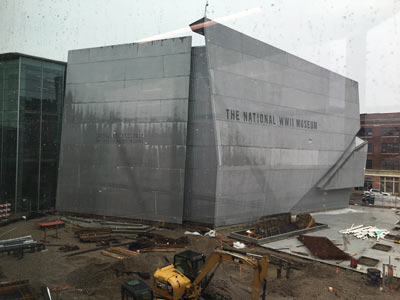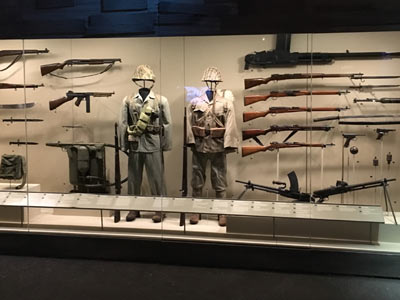The National WWII Museum is not a gun museum per se. Founded by Dr. Stephen E. Ambrose, it opened in 2000 as the National D-Day Museum. In 2004 the U.S. Congress designated it as America’s official WWII museum. Its downtown campus has grown to include five pavilions with two more in development. Additionally, it has an affiliation with the Smithsonian Institution. The museum has 100,000 artifacts ‘including but not limited to Allied and Axis uniforms, weaponry, vehicles, aircraft, medals, diaries, letters, artwork, photographs and other mementos.’ The exhibits take an immersive approach structured around large black & white photographs, giving the visitor rich context including sound effects and lighting, set-design elements reproducing foliage, architectural details, and terrain. Within these galleries, larger weapons can be seen placed within their appropriate context. Three separate “Arms and Men” exhibits feature collections of opposing weapons side by side. In the D-Day Gallery and Road to Berlin, there are German and Allied weapons; in Road to Tokyo, Japanese and US weapons. Each exhibit has a fine display of the essential twenty-five to thirty firearms used in that theater, and may include heavy and light machineguns, machine pistols, rifles, carbines, hand guns, hand-grenades and ‘bazookas’. Additional firearms are in scattered cases. Incredulously, the curators have seen fit to exclude all firearms from the armies of Great Britain, its Empire, Australia and New Zealand, who fought closely alongside the U.S. Army, not to mention allied Soviet and French weapons. In the explosive expansion of the National WWII Museum over the last decade, the current curatorial stance is compromised by its original mission to focus on America’s contribution to WWII. It is now time to appropriately acknowledge America’s allies, as does the National WWI Museum in Kansas City. The ‘Digital Collections’ of the museum are fascinating, but not for students of firearms. It has several videos of every aspect of WWII, including specific firearms, and a good digital photo archive. But, if ‘M1 Garand Rifle’ is typed into the WW2online search engine, the response is, ‘no items matching your enquiry’. If the word ‘rifle’ is entered, sixty-five compelling WWII black & white photographs are shown. However, the museum gives weekly tours of its vault, called “Behind the Lines,” during which visitors can view and handle firearms not currently on display. http://www.nationalww2museum.org/


 1. West Point Museum
1. West Point Museum 2. Springfield Armory
2. Springfield Armory 3. Smithsonian Museum
3. Smithsonian Museum 4. Nunnemacher Milwaukee
4. Nunnemacher Milwaukee 5. Wadsworth Atheneum
5. Wadsworth Atheneum 6. Rock Island Arsenal
6. Rock Island Arsenal 7. Metropolitan Museum NY
7. Metropolitan Museum NY 8. National World War I
8. National World War I 9. FBI Reference Collection
9. FBI Reference Collection 10. NRA National Firearms
10. NRA National Firearms 11. Connecticut History
11. Connecticut History 12. Remington Firearms
12. Remington Firearms 13. Davis Arms Museum
13. Davis Arms Museum 14. National Cowboy Mus.
14. National Cowboy Mus. 15. American Precision
15. American Precision 16. Collectors Firearms
16. Collectors Firearms 17. KY Military History
17. KY Military History 18. Cody Firearms Museum
18. Cody Firearms Museum 19. Woolaroc Museum
19. Woolaroc Museum 20. Kienbusch Philadelphia
20. Kienbusch Philadelphia 21. John Browning Museum
21. John Browning Museum 22. Art Institute Chicago
22. Art Institute Chicago 23. Henry Stewart VMI
23. Henry Stewart VMI 24. Autry Museum
24. Autry Museum 25. Wood Museum S&W
25. Wood Museum S&W 26. National WWII Museum
26. National WWII Museum 27. Frazier History Museum
27. Frazier History Museum 28. Pennsylvania Longrifle
28. Pennsylvania Longrifle 29. Frank Brownell Museum
29. Frank Brownell Museum 30. Inst. Mil. Technology
30. Inst. Mil. Technology 31. NRA Bass Pro Sporting
31. NRA Bass Pro Sporting 32. U S Army Museum
32. U S Army Museum